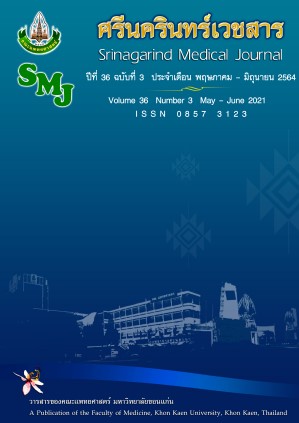The Result of Continuous Antibiotics Injection in Out Patient, Sawanpracharak Hospital
Keywords:
antibiotic; out patient; Outpatient parenteral antimicrobial therapy (OPAT); length of stayAbstract
Background and Objective: Increasing the use of outpatient intravenous antibiotic therapy and Outpatient parenteral antimicrobial therapy (OPAT) program have been developed standardization in many country. Objective of this research is to assess the effects of continuous antibiotic injection in the treatment of infectious diseases in outpatients who receiving medicine at Sawanpracharak Hospital
Methods: The descriptive study was performed in 529 outpatients receiving antibiotic injection between 1 October 2019 to 30 September 2020.
Results: According to the study, 616 episodes OPAT for 529 patients were prescribed. The department which was the highest amount of prescribing was internal medicine (289 episodes, 46.90 %). The most commonly prescribed drug was ceftriaxone 426 episodes (67.73%). The most infectious disease was urinary tract infections 228 episodes (37.01%). There were 318 patients ( 51.62%) using an outpatient injection service at Sawanpracharak Hospital. The most drug related problem prescription error was that the type of solution and the dose rate of administration was not specified 98.92%. Treatment outcomes were clinical improvement by 90.90% and 4.06% of patients had to admit in hospital for treatment infection. There were adverse drug event 3 cases and none-compliance 18 cases.
Conclusion: Outcomes of The continuous antibiotic injection in outpatients. there was clinical improvement 90.90 % can reduce length of stay and also reduce the cost of hospital stay by more than 2.5 million bahts per year. Orientation for referring to patients by pharmacists. There were adverse drug event 3 cases and none-compliance 2.92%.
References
2. Beieler AM, Dellit TH, Chan JD, Dhanireddy S, Enzian LK, Stone TJ, et al. Successful implementation of outpatient parenteral antimicrobial therapy at a medical respite facility for homeless patients. J Hosp Med 2016; 11(8): 531-535. doi: 10.1002/jhm.2597.
3. Williams DN, Baker CA, Kind AC and Sannes MR. The history and evolution of outpatient parenteral antibiotic therapy (OPAT). Int J Antimicrob Agents 2015; 46(3): 307-12.
4. Chapman AL, Seaton RA, Cooper MA, Hedderwick S, Goodall V, Reed C, et al. Good practice recommendations for outpatient parenteral antimicrobial therapy (OPAT) in adults in the UK: a consensus statement. J Antimicrob Chemother 2012; 67: 1053–1062. https://doi.org/10.1093/jac/dks003.
5. Vargas-Palacios A, Meads DM, Twiddy M, Czoski MC, Hulme C, Mitchell ED, et al. Cost-effectiveness of outpatient parenteral antibiotic therapy: a simulation modelling approach. J Antimicrob Chemother 2017; 72(8): 2392-2400.
6. Erba A, Beuret M, Daly ML, Khanna N, Osthoff M. OPAT in Switzerland: single-center experience of a model to treat complicated infections. Infection 2020; 48(2): 231-240. https://doi.org/10.1007/s1501 0-019-01381-8.
7. Rigor J, Ferreira PM, Murteira F, Figueiredo C, Vieira N, Oliveira R, et al. Antibiotic clinic: two years’ experience in outpatient parenteral antimicrobial therapy in a Portuguese hospital. Acta Med Port 2019; 32: 576–579. https://doi.org/10.20344/amp.11730.
8. Wee LE, Sundarajoo M, Quah WF, Farhati A, Huang JY, Chua YY. Health-related quality of life and its association with outcomes of outpatient parenteral antibiotic therapy. Eur J Clin Microbiol Infect Dis 2020; 39: 765–772. https://doi.org/10.1007/s10096-019-03787-6
9. Zhang J, Moore E, Bousfield R. OPAT for cellulitis: its benefits and the factors that predispose to longer treatment. Eur J Clin Microbiol Infect Dis 2016; 35(6): 1013-1015.
10. Quintens C, Steffens E, Jacobs K, Schuermans A, Van Eldere J, Lagrou K, et al. Efficacy and safety of a Belgian tertiary care outpatient parenteral antimicrobial therapy (OPAT) program. Infection 2020 ; 48(3): 357-366.
11. Mitchell ED, Czoski Murray C, Meads D, Minton J, Wright J, Twiddy M. Clinical and cost-effectiveness, safety and acceptability of community intravenous antibiotic service models: CIVAS systematic review. BMJ Open 2017; 7(4): e013560.




